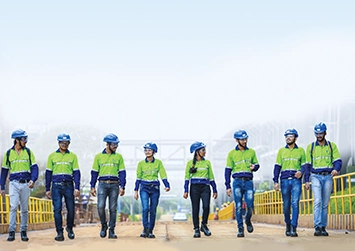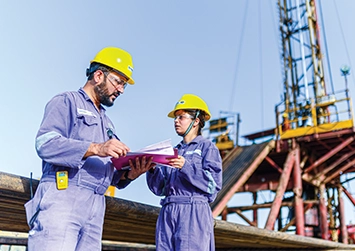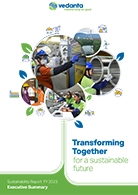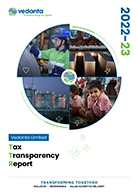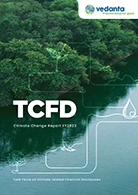RISK MANAGEMENT
MANAGING RISKS AND OPPORTUNITIES AMIDST A DYNAMIC EXTERNAL ENVIRONMENT
As our operations are spread globally, our businesses are exposed to a variety of risks. Our multi-layered risk management system and robust governance framework help us align our operating controls with the Group’s overarching vision and mission. This, in turn, helps us deliver on our strategic objectives.
Risk Governance Framework
Enterprise risk management
For our existing operations and ongoing projects, we identify risks at the individual business-level by way of a consistently applied methodology. We undertake business-level review meetings at least once every quarter to discuss risk management formally. Within the Group, every business division has created and evolved its risk matrix and developed its risk registers. The respective business divisions review the risks, changes in the nature and extent of major risks since the last assessment and control measures, and then decide on further action plans. These risks are then reviewed by the Business Management Committee.
The business management teams also periodically review control measures stated in the risk matrix in order to verify their effectiveness. The CEOs of respective businesses chair these meetings, which are also attended by CXOs, senior management and the functional heads. At the business and Group level, the role of Risk Officers is to create awareness among the senior management on risks and to develop and nurture a risk-management culture within the businesses. An integral part of KRAs and KPIs of process owners is to come up with risk mitigation plans. The governance of the risk management framework is anchored with the leadership teams of individual businesses.
By identifying and assessing changes in risk exposure, reviewing risk-control measures and approving remedial actions, wherever appropriate, the Audit & Risk Management Committee aids the Board in its risk management process. This Committee is supported by the Group Risk Management Committee (GRMC), which helps evaluate the design and operating effectiveness of the risk mitigation programme and control systems. This analysis discusses risks and mitigation measures, reviews the robustness of our framework at an individual business level and maps progress against actions planned for key risks by meeting at least four times annually.
The GRMC, which meets every quarter, discusses key events impacting the risk profile, relevant risks and uncertainties, emerging risks and progress against planned actions. This committee comprises the Group Chief Executive Officer, Group Chief Financial Officer and Director-Management Assurance. The Group Head - Health, Safety, Environment & Sustainability are also invited to attend these meetings.
The risk management framework, which is simple and consistent, provides clarity on managing and reporting risks to the Board. Our management systems, organisational structures, processes, standards and Code of Conduct and ethics together represent our internal control systems. These internal control systems govern how the Group conducts its business and manages associated risks.
The Board shoulders the ultimate responsibility for the management of risks and for ensuring the effectiveness of these internal control systems. The Board’s responsibility includes a review of the Audit & Risk Management Committee’s report on the risk matrix, significant risks, and mitigating actions. A regular review is conducted of any systemic weaknesses identified and addressed by enhanced procedures to strengthen the relevant controls.
Group Risk Management Framework
Risk management is embedded in business-critical activities, functions and processes. This is also critical to deliver on the Group’s strategic objectives. The Company’s risk management framework is designed to manage, not eliminate, the risk of failure to achieve its business objectives. The framework provides reasonable, (not absolute), assurance against material misstatement or loss. The key considerations of our decision-making are materiality and risk tolerance.
Every manager and business leader is responsible for identifying and managing risks. The key risk governance and oversight committees in the Group are as below:
- The Board is supported by the Committee of Directors (COD), comprising the Vice Chairman and Group CFO, by considering, reviewing and approving the borrowing and investment-related proposals within the overall limits approved by the Board. The CEO, Business CFOs, Group Head Treasury and BU Treasury Heads, based on the agenda, are invited to these committee meetings
- The Audit and Risk Management Committee, along with Sustainability Committee, review sustainability-related risks
- Various group-level ManCom such as Procurement ManCom, Sustainability - HSE ManCom, and CSR ManCom work on identifying specific risks and working out mitigation plans
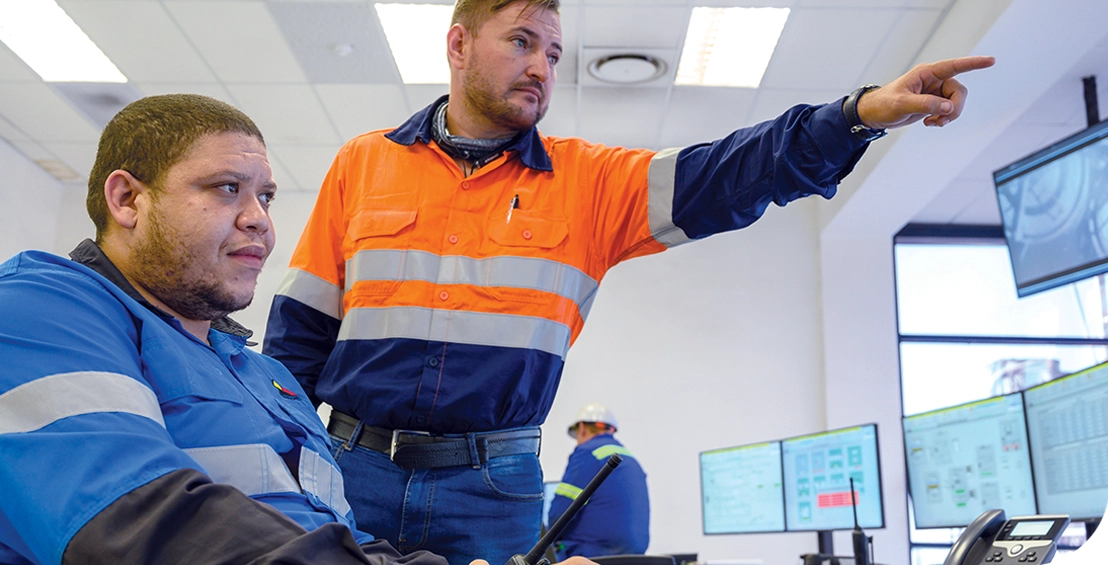
Control Room at VZI
Every business has developed its risk matrix, which is reviewed by the respective management committee/executive committee, chaired by its CEO. In addition, depending on the size of its operations and the number of SBUs/locations, every business has developed its risk register. Across these risk registers, the risks are aggregated and evaluated, the Group’s principal risks are identified, and an adequate response mechanism is formulated.
It is this element which is an important component of the overall internal control process, from which the Board obtains assurance. The scope of work, authority and resources of the Management Assurance Services (MAS) are regularly reviewed by the Audit Committee. Recommending improvements in the control environment and reviewing compliance with our philosophy, policies and procedures are the key responsibilities of MAS.
It is from the risk perspective that the planning of internal audits is approached. Inputs are sought from the senior management, business teams and members of the Audit Committee and reference is made to the risk matrix while preparing the internal audit plan. The past audit experience, financial analysis and prevailing economic and business environment are also referred to in the process.
In the section that follows, the order in which risks appear does not necessarily reflect the likelihood of occurrence or the relative magnitude of their impact on Vedanta’s businesses. For each risk, the risk direction is reviewed based on the events, economic conditions, changes in the business environment and regulatory changes during the year.
The Company’s risk management framework has been formulated to help the organisation meet its objectives. However, there is no guarantee that the Group’s risk management activities will mitigate these risks or prevent them, or other risks, from occurring.
With the assistance of the management, the Board conducts periodic and robust assessments of principal risks and uncertainties of the Group, while also testing the financial plans associated with each.
Health, safety and environment (HSE)
Impact: The resources sector is subject to extensive health, safety and environmental laws, regulations and standards. Evolving requirements and stakeholder expectations could result in increased costs or litigation or threaten the viability of operations in extreme cases. Large-scale environmental damage is amongst the top 10 risks, as per the World Economic Forum’s Global Risk Report 2023 for the next 2 years, which can lead to global policy changes
Emissions and climate change
Climate change mitigation and adaption failure is ranked amongst the top 10 risks as per World Economic Forum’s Global Risk Report 2023 over the next 2 years to 10 years. Our global presence exposes us to a number of jurisdictions in which regulations or laws have been, or are being, considered to limit or reduce emissions. The likely effect of these changes could be to increase the cost of fossil fuels, imposition of levies for emissions in excess of certain permitted levels and increase administrative costs for monitoring and reporting. Increasing regulation of greenhouse gas (GHG) emissions, including the progressive introduction of carbon emissions trading mechanisms and tighter emission reduction targets, is likely to raise costs and reduce demand growth
Mitigation
- HSE is a high-priority area for Vedanta. Compliance with international and local regulations and standards, protecting our people, communities and the environment from harm, and our operations from business interruptions, are the key focus areas
- Policies and standards are in place to mitigate and minimise any HSE-related occurrences. Safety standards are issued or continue to be issued to reduce the risk level in high-risk areas. Structured monitoring, a review mechanism and a system of positive compliance reporting are in place
- BU leadership continues to emphasise on three focus areas: visible felt leadership, safety-critical tasks and managing business partners
- The process to improve learning from incidents is currently being improved to reduce the re-occurrence of similar incidents
- A Vedanta Critical Risk Management programme will be launched to identify critical risk controls and to measure, monitor and report control effectiveness
- The Company has implemented a set of standards to align its sustainability framework with international practices. A structured sustainability assurance programme continues to operate in the business divisions covering environment, health, safety, community relations and human rights aspects. This is designed to embed our commitment at the operational level
- All businesses have appropriate policies in place for occupational health-related matters, supported by structured processes, controls and technology
- To provide incentives for safe behaviour and effective risk management, safety KPIs have been built into the performance management of all employees
- The carbon forum has been re-constituted with updated terms of reference and representation from all businesses. Its mandate is to develop and recommend the carbon agenda for the Group to the Executive Committee (ExCo) and Board
- Enhanced focus on renewable power obligations
- The Group companies are actively working on reducing the intensity of GHG emissions in our operations
- A task force team is formulated to assess end-to-end operational requirements for the FGD plant. We continue to engage with various stakeholders on the matter
Managing relationship with stakeholders
Impact: The continued success of our existing operations and future projects is partly dependent on the broad support and healthy relationships with our local communities. Failure to identify and manage local concerns and expectations can have a negative impact on relations and, therefore, can affect the organisation's reputation and social licence to operate and grow
Mitigation
- Our CSR approach to community programmes are governed by the following key considerations relating to the needs of the local people and the development plan in line with the new Companies Act in India; CSR Guidelines; CSR National Voluntary Guidelines of the Ministry of Corporate Affairs, Government of India; and the UN’s Sustainable Development Goals (SDGs)
- Our BU teams are proactively engaging with communities and stakeholders through a proper and structured engagement plan, with the objective of working with them as partners
- A group-level CSR management committee meets every fortnight to review and decide on strategic CSR Planning, its execution and communication
- Business Executive Committee (ExCo) factor in these inputs, and then decide upon the focus areas of CSR and budgets, in alignment with strategic business priorities
- All BUs follow well-laid processes for recording and resolving all community and external grievances as well as standard processes for social investment
- Every business has a dedicated Community Development Manager, who is a part of the BU ExCo. They are supported by dedicated teams of community professionals
- Our business leadership teams have periodic engagements with the local communities to build relations based on trust and mutual benefit. Our businesses seek to identify and minimise anypotentially negative operational impact and risks through responsible behaviour – that is, acting transparently and ethically, promoting dialogue and complying with commitments to stakeholders
- Stakeholder engagement is driven basis the stakeholder engagement plan at each BU by the CSR and cross-functional teams. Regular social and environmental risk assessment discussions happen at the BU-level
- Strategic CSR communication is being worked upon for visibility. Efforts continue to meet with key stakeholders, showcase our state-of-the-art technology, increase organic followers and enhance engagement through social media
- CSR communication and engagement with all stakeholders – within and outside communities
Tailings dam stability
Impact: The release of waste material can lead to loss of life, injuries, environmental damage, reputational damage, financial costs and production impacts. A tailings dam failure is considered to be a catastrophic risk – i.e., a very high severity, but very low-frequency event and is a continuous risk. Hence, it receives the highest priority
Mitigation
- The Risk Management Committee included a tailings dam on the Group risk register with a requirement for an annual internal review and a three-yearly external review
- Operation of the tailings dam is executed by suitably experienced personnel within the businesses
- Third party has been engaged to review tailings dam operations, including the improvement opportunities and remedial works required in addition to the application of Operational Maintenance and Surveillance (OMS) manuals in all operations. This is an oversight role in addition to the technical design and guidance arranged by respectiveBUs. Technical guidelines are also being developed
- Vedanta Tailings Management Standard has been reviewed, augmented and reissued, including an annual, independent review of every dam and a half-yearly CEO sign-off that dams continue to be managed within the design parameters and in accordance with the last surveillance audit. Move towards dry tailings facilities has commenced
- Those responsible for dam management receive training from third parties and will receive ongoing support and coaching from international consultants
- Management standards implemented with business involvement
- BUs are expected to ensure ongoing management of all tailings facilities with ExCo oversight with independent third-party assessment on the YoY implementation status of Golder recommendations
- Digitalisation of tailings monitoring facilities is being carried out at the BUs
- Tailing management standard is updated to include latest best practices in tailing management. The UNEP/ICMM Global Tailings Standard was incorporated into Vedanta Standard during FY 2021
Challenges in Aluminium and Power business
Impact: Our projects have been completed and may be subject to a number of challenges during operationalisation. These may also include challenges around sourcing raw materials and infrastructure-related aspects and concerns around ash utilisation/evacuation
Mitigation
- Despite the fluctuation in LME along with pressure on cost, best-ever production outcomes have resulted in a sustained performance in the Aluminium sector
- Despite improvement in costs QoQ, along with improved raw material security, alumina refinery expansion from 2 MTPA to 5 MTPA is being pursued
- Tapping of new coal mines and sourcing of bauxite have been beneficial for plant operations
- Continue to pursue new coal linkages to ensure coal security
- Inbound and outbound supply chains across rail, road and ocean including manpower are functioning well, with no major risks foreseen
- Local sourcing of bauxite and alumina from Odisha Jharsuguda facilities ramped up satisfactorily
- Project teams in place for ash pond, red mud, railway infrastructure and FGD
- Dedicated teams working towards addressing the issue of new emission norms for power plants
- Global technical experts inducted to strengthen operational excellence
- Continuous focus on plant operating efficiency improvement programme to achieve design parameters, manpower rationalisation, logistics and cost reduction initiatives
- Continuous augmentation of power security and infrastructure
- Strong management team continues to work towards sustainable low-cost production, operational excellence and securing key raw material linkages
- Talwandi Saboo (TSPL) power plant matters are being addressed structurally by a competent team
Discovery risk
Impact: Increased production rates from our growth-oriented operations create demand for exploration and prospecting initiatives so that reserves and resources can be replaced at a pace faster than depletion. Failure in our ability to discover new reserves, enhance existing reserves or develop new operations in sufficient quantities to maintain or grow the current level of our reserves could negatively affect our prospects. There are numerous uncertainties inherent in estimating ore and oil and gas reserves, and geological, technical, and economic assumptions that are valid at the time of estimation, may change significantly when new information becomes available
Mitigation
- Exploration Executive Committee has been established to develop and implement strategy and review projects group-wide
- Dedicated exploration cell with a continuous focus on enhancing exploration capabilities
- Appropriate organisation and adequate financial allocation in place for the exploration
- Strategic priority is to add to our reserves and resources by extending resources at a faster rate than we deplete them, through continuous focus on the drilling and exploration programme
- Continue to make applications for new exploration tenements in countries in which we operate under their respective legislative regimes
- Exploration-related systems are being strengthened and standardised across the Group, and new technologies are being utilised wherever appropriate
- International technical experts and agencies are working closely with our exploration teams to enhance our capabilities
Breaches in IT/cybersecurity
Impact: Like many global organisations, our reliance on computers and network technology is increasing. These systems could be subject to security breaches resulting in theft, disclosure, or corruption of key/strategic information. Security breaches could also result in misappropriation of funds or disruptions to our business operations. A cybersecurity breach could impact business operations
Mitigation
- Group-level focus on formulating necessary frameworks, policies, and procedures in line with best practices and international standards
- Implementation and adoption of various best-in-class tools and technologies for information security to create a robust security posture
- RCM (Risk Control Matrix) and IT General Controls (ITGC) under SOx framework are performed as per defined frequency and effectiveness
- Structured and well-defined cyber security awareness program to cover all classes of stakeholders, including employees and the leadership
- Special focus to strengthen the security landscape of plant technical systems (PTS) through various initiatives
- Adoption of various international standards related to information security, disaster recovery and business continuity management, IT risk management and setting up of internal IT processes and practices in line with these standards
- Work towards ensuring strict adherence to IT-related SOPs to improve operating effectiveness, continuous focus on mandatory employee training on cybersecurity awareness
- Periodic assessment of entire IT system landscapes and governance framework from vulnerability and penetration perspective, undertaken by reputed expert agencies and addressing the identified observations in a time-bound manner
- Structured and well-defined cyber security awareness programme in place to cover all classes of stakeholders from employees to leadership and will include Board members too
Loss of assets or profit due to natural calamities
Impact: Our operations may be subject to a number of circumstances not wholly within the Group's control. These include damage to or breakdown of equipment or infrastructure, unexpected geological variations or technical issues, extreme weather conditions and natural disasters – any of which could adversely affect production and/or costs.
Mitigation
- Vedanta has taken an appropriate Group insurance cover to mitigate this risk and an Insurance Council is in place to monitor the adequacy of coverage and status of claims
- An external agency reviews the risk portfolio and adequacy of this cover and assists us in reviewing our insurance portfolio
- We engage underwriters from reputed institutions to underwrite our risk
- Established mechanisms of periodic insurance review in place at all entities. However, any occurrence not fully covered by insurance could have an adverse effect on the Group's business
- Continuous monitoring and periodic review of security and insurance function
- Continue to focus on capability building within the Group
Cairn-related challenges
Impact: Cairn India has 70% participating interest in Rajasthan Block, the production sharing contract (PSC) of which was valid till 2020. The Government of India has granted its approval for a 10-year extension at less favourable terms, pursuant to its policy for extension of Pre-New Exploration and Licensing Policy (NELP) Exploration Blocks, subject to certain conditions. Ramp-up of production compared with what was envisaged may impact profitability
Mitigation
- Rajasthan PSC extension for 10 years from 15 May 2020 to 14 May 2030 has been executed by the parties to the PSC on 27 October 2022
- The applicability of the Pre-NELP Extension Policy to the RJ Block is currently sub judice
-
Focussed efforts on managing production decline
through:
– Infill wells across producing fields
– Enhanced recovery projects in key producing fields
– Exploration drilling across the portfolio to add resources - Project Management Committee and Project Operating Committee were set up to provide support to the outsourcing partner and address issues on time to enable better quality control and timely execution of growth projects
Regulatory and legal risk
Impact: We have operations in many countries around the globe. These may be impacted because of legal and regulatory changes in the countries in which we operate, resulting in higher operating costs, and/or restrictions such as the imposition or increase in royalties or taxation rates, export duty, impact on mining rights/bans, and changes in legislation.
Mitigation
- The Group and its business divisions monitor regulatory developments on an ongoing basis
- Business-level teams identify and meet regulatory obligations and respond to emerging requirements
- Focus on communicating our responsible mining credentials through representations to government and industry associations
- Continue to demonstrate the Group's commitment to sustainability through proactive environmental, safety and CSR practices. Ongoing engagement with local community/media/NGOs
- SOx-compliant subsidiaries
- Common compliance monitoring system being implemented in Group companies. Legal requirements and a responsible person for compliance have been mapped in the system
- Legal counsels within the Group continue to work on strengthening the compliance and governance framework and the resolution of legal disputes
- A competent in-house legal organisation is in place at all the businesses; these legal teams have been strengthened with the induction of senior legal professionals across all Group companies
- SOPs implemented across our businesses for compliance monitoring
- Greater focus on timely closure of key non-compliances
- Contract management framework was strengthened with the issue of boilerplate clauses across the Group, which will form a part of all contracts. All key contract types have also been standardised
- Framework for monitoring performance against anti-bribery and corruption guidelines is in place
Tax related matters
Impact: Our businesses are in a tax regime and changes in any tax structure, or any tax-related litigation may impact our profitability.
Mitigation
- Tax Council reviews all key tax litigations and provides advice to the Group
- Continue to engage with authorities concerned on tax matters
- Robust organisation in place at the business and Group-level to handle tax-related matters
- Continue to consult and obtain opinions from reputable tax consulting firms on major tax matters to mitigate tax riskson the Group and its subsidiaries
- Strengthened governance in foreign subsidiaries
Price (metal, oil, ore, power, others), currency and interest rate volatility
Impact: Prices and demand for the Group's products may remain volatile/uncertain and could be influenced by global economic conditions, natural disasters, weather, pandemics, such as the COVID-19 outbreak, political instability, and so on. Volatility in commodity prices and demand may adversely affect our earnings, cash flow and reserves.
Our assets, earnings and cash flow are influenced by a variety of currencies due to our multi-geographic operations. Fluctuations in exchange rates of those currencies may have an impact on our financials
Mitigation
- The Group’s well-diversified portfolio acts as a hedge against fluctuations in commodities and delivers cashflow through the cycle
- Pursue low-cost production, allowing profitable supply throughout the commodity price cycle
- Vedanta considers exposure to commodity price fluctuations to be integral to the Group's business and its usual policy is to sell its products at prevailing market prices. Its policy is not to enter into price hedging arrangements other than for businesses of custom smelting and purchased alumina, where back-to-back hedging is used to mitigate pricing risks. Strategic hedge, if any, is taken after appropriate deliberations and due approval from ExCo
- Our forex policy prohibits forex speculation
- Robust controls in forex management to hedge currency risk liabilities on a back-to-back basis
- Finance Standing Committee reviews all forex and commodity-related risks and suggests necessary course of action to business divisions
- Seek to mitigate the impact of short-term currency movements on businesses by hedging short-term exposures progressively, based on their maturity. However, large, or prolonged movements in exchange rates may have a material adverse effect on the Group's businesses, operating results, financial condition and/or prospects
- Notes to the financial statements in the Annual Report provide details of the accounting policy followed in calculating the impact of currency translation
- Any sharp movements in commodity prices are discussed at the Group commercial and marketing Mancoms and suitable actions are discussed, deliberated and implemented
Major project delivery
Impact: Shortfall in the achievement of stated objectives of expansion projects, leading to challenges in achieving stated business milestones – existing and new growth projects.
Mitigation
- Project management organisation cell set up at a Group level with the objective of monitoring growth project progress, extracting useful insights through market research, leveraging data analytics and benchmarking with best-in-class projects
- Empowered organisation structure in place to drive growth projects; project management systems streamlined to ensure full accountability and value stream mapping
- Strong focus on safety aspects in the project
- Geo-technical audits conducted by independent agencies
- Engaged global engineering partner to do complete life of mine planning and capital efficiency analysis to ensure that the project objectives are in sync with the business plan and growth targets
- Standard specifications and SOPs were developed for all operations to avoid variability; reputed contractors engaged to ensure the completion of the project on indicated timelines
- Use of best-in-class technology and equipment to develop mines, ensuring the highest level of productivity and safety. Digitisation and analytics help improve productivity and recovery
- Stage gate process to review risks and remedy at multiple stages on the way
- Robust quality control procedures implemented to check the safety and quality of services/design/actual physical work
- Use of a reputed international agency for Geotech modelling and technical support, wherever required
Access to capital
Impact: The Group may be unable to meet its payment obligations when due or may be unable to borrow funds in the market at an acceptable price to fund actual or proposed commitments. A sustained adverse economic downturn and/or suspension of its operations in any business, affecting revenue and free cash flow generation, may cause stress on the Company's ability to raise financing at competitive terms.
Mitigation
- Focussed team continues to work on proactive refinancing initiatives with an objective to contain cost and extend tenure
- Team is actively building the pipeline for long-term funds for near-to-medium term requirements, both for refinancing and growth capex
- Track record of good relations with banks, and of raising borrowings in the last few years
- Regular discussions with rating agencies to build confidence in operating performance
- Business teams ensure continued compliance with the Group’s treasury policies that govern our financial risk management practices
- CRISIL and India ratings maintained ratings at “AA” with the outlook revised to negative from stable
-
Decrease in risk profile
-
Same as last year
-
Increase in risk profile

